MN4063QA NOV21 Coursework RESIT - Desklib
VerifiedAdded on 2023/06/04
|10
|1417
|98
AI Summary
Get solved assignments, essays, dissertations, and study material for MN4063QA NOV21 Coursework RESIT at Desklib. Analyze data, use appropriate tools, and enhance your numeracy skills.
Contribute Materials
Your contribution can guide someone’s learning journey. Share your
documents today.
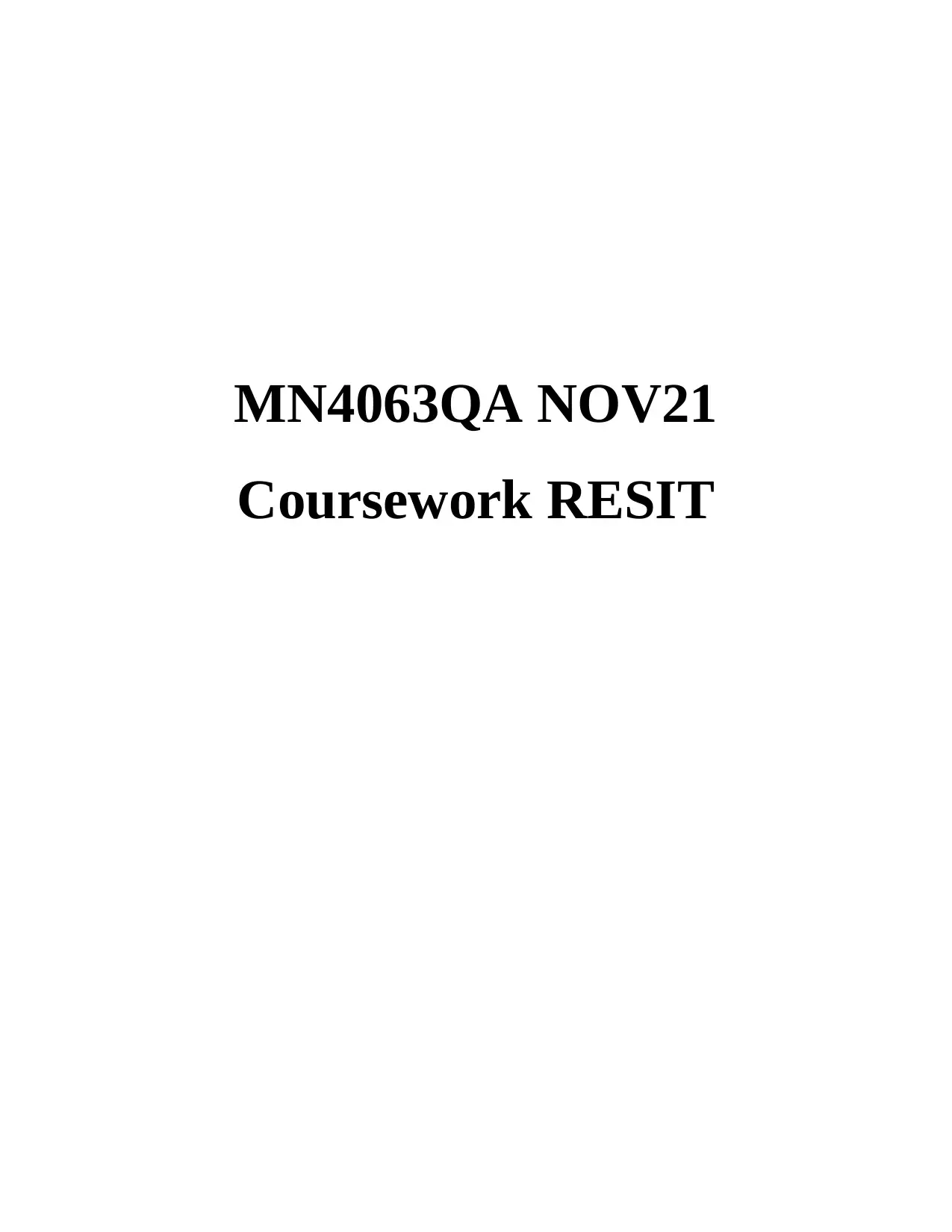
MN4063QA NOV21
Coursework RESIT
Coursework RESIT
Secure Best Marks with AI Grader
Need help grading? Try our AI Grader for instant feedback on your assignments.

TABLE OF CONTENTS
PART 1............................................................................................................................................3
TASK 1.......................................................................................................................................3
TASK 2.......................................................................................................................................3
TASK 3.......................................................................................................................................4
TASK 4.......................................................................................................................................4
TASK 5.......................................................................................................................................6
TASK 6.......................................................................................................................................7
TASK 7.......................................................................................................................................8
PART 2............................................................................................................................................8
A..................................................................................................................................................8
B..................................................................................................................................................8
C..................................................................................................................................................8
D..................................................................................................................................................9
E..................................................................................................................................................9
REFERENCES..............................................................................................................................10
PART 1............................................................................................................................................3
TASK 1.......................................................................................................................................3
TASK 2.......................................................................................................................................3
TASK 3.......................................................................................................................................4
TASK 4.......................................................................................................................................4
TASK 5.......................................................................................................................................6
TASK 6.......................................................................................................................................7
TASK 7.......................................................................................................................................8
PART 2............................................................................................................................................8
A..................................................................................................................................................8
B..................................................................................................................................................8
C..................................................................................................................................................8
D..................................................................................................................................................9
E..................................................................................................................................................9
REFERENCES..............................................................................................................................10
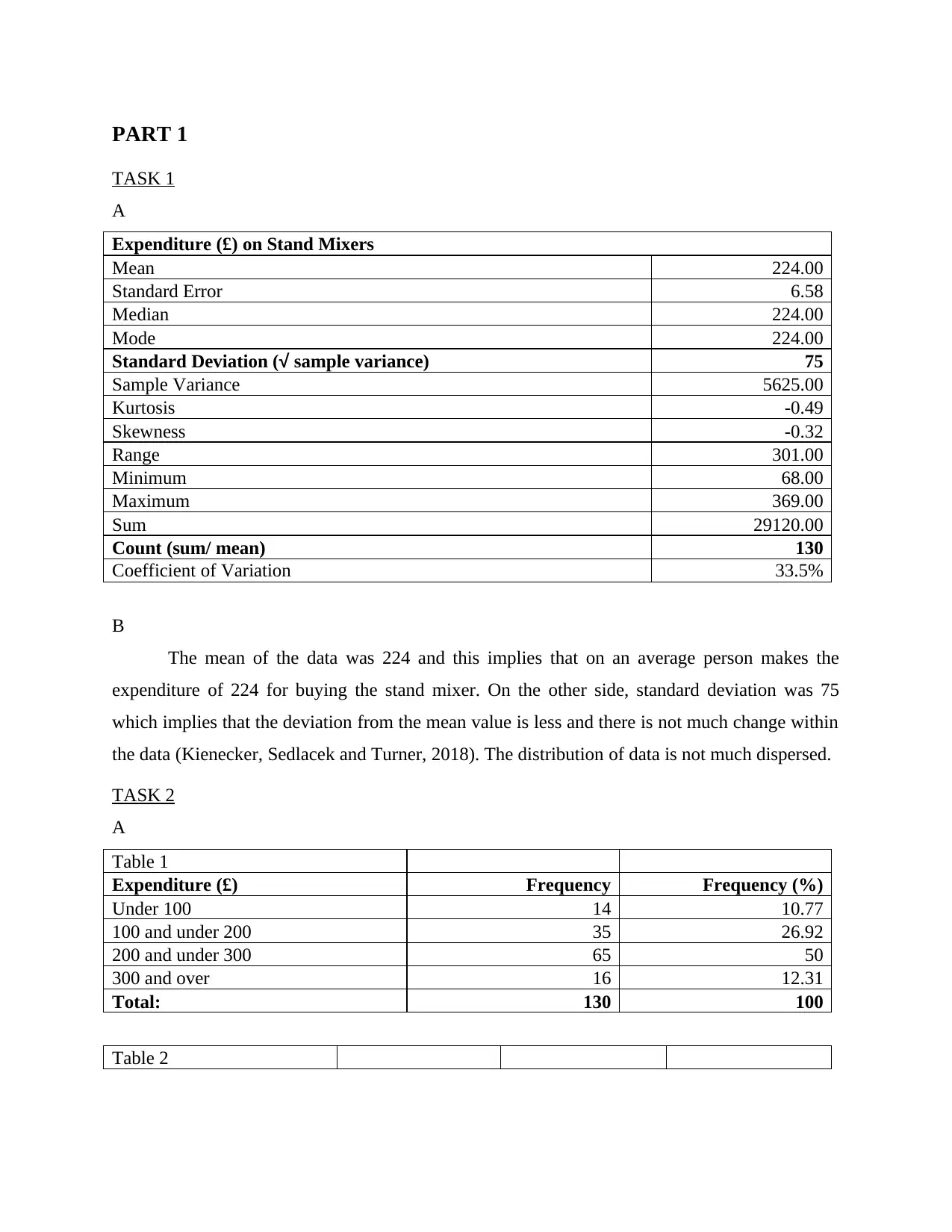
PART 1
TASK 1
A
Expenditure (£) on Stand Mixers
Mean 224.00
Standard Error 6.58
Median 224.00
Mode 224.00
Standard Deviation (√ sample variance) 75
Sample Variance 5625.00
Kurtosis -0.49
Skewness -0.32
Range 301.00
Minimum 68.00
Maximum 369.00
Sum 29120.00
Count (sum/ mean) 130
Coefficient of Variation 33.5%
B
The mean of the data was 224 and this implies that on an average person makes the
expenditure of 224 for buying the stand mixer. On the other side, standard deviation was 75
which implies that the deviation from the mean value is less and there is not much change within
the data (Kienecker, Sedlacek and Turner, 2018). The distribution of data is not much dispersed.
TASK 2
A
Table 1
Expenditure (£) Frequency Frequency (%)
Under 100 14 10.77
100 and under 200 35 26.92
200 and under 300 65 50
300 and over 16 12.31
Total: 130 100
Table 2
TASK 1
A
Expenditure (£) on Stand Mixers
Mean 224.00
Standard Error 6.58
Median 224.00
Mode 224.00
Standard Deviation (√ sample variance) 75
Sample Variance 5625.00
Kurtosis -0.49
Skewness -0.32
Range 301.00
Minimum 68.00
Maximum 369.00
Sum 29120.00
Count (sum/ mean) 130
Coefficient of Variation 33.5%
B
The mean of the data was 224 and this implies that on an average person makes the
expenditure of 224 for buying the stand mixer. On the other side, standard deviation was 75
which implies that the deviation from the mean value is less and there is not much change within
the data (Kienecker, Sedlacek and Turner, 2018). The distribution of data is not much dispersed.
TASK 2
A
Table 1
Expenditure (£) Frequency Frequency (%)
Under 100 14 10.77
100 and under 200 35 26.92
200 and under 300 65 50
300 and over 16 12.31
Total: 130 100
Table 2

Expenditure (£) Frequency
Cumulative
Frequency
Cumulative
Frequency (%)
Under 100 14 14 4.56
Under 200 35 49 15.96
Under 300 65 114 37.13
Under 400 16 130 42.35
Total: 130 307 100
Table 3
Expenditure (£)
Frequency
(f)
midpoint
(x) fx
(x-
mean)
(x-
mean)2 f(x-mean)2
Under 100 14 50 700 17.5 306.25 4287.5
100 and under
200 35 150 5250 117.5 13806.25 483218.75
200 and under
300 65 250
1625
0 217.5 47306.25
3074906.2
5
300 and over 16 350 5600 317.5
100806.2
5 1612900
Total: 130 800
2780
0 670 162225 5175312.5
Mean 32.5
Variance 419.25
Standard Deviation 20.47559523
B
With help of ogive it is clear that the minimum number of amount that consumer need to
spend to belong to bottom 25 % is 100.
TASK 3
The major difference between the cross sectional and time series data is that the former
focuses on having data from many units but for a specific point of time only. Whereas the latter
involves gathering data form one unit but over many point of time (Pangrazio and Selwyn,
2019). In case of collecting the data relating to demographic profile and lifestyle characteristic
the use of time series data will be beneficial as it will be having more data to be analysed from.
TASK 4
A
Cumulative
Frequency
Cumulative
Frequency (%)
Under 100 14 14 4.56
Under 200 35 49 15.96
Under 300 65 114 37.13
Under 400 16 130 42.35
Total: 130 307 100
Table 3
Expenditure (£)
Frequency
(f)
midpoint
(x) fx
(x-
mean)
(x-
mean)2 f(x-mean)2
Under 100 14 50 700 17.5 306.25 4287.5
100 and under
200 35 150 5250 117.5 13806.25 483218.75
200 and under
300 65 250
1625
0 217.5 47306.25
3074906.2
5
300 and over 16 350 5600 317.5
100806.2
5 1612900
Total: 130 800
2780
0 670 162225 5175312.5
Mean 32.5
Variance 419.25
Standard Deviation 20.47559523
B
With help of ogive it is clear that the minimum number of amount that consumer need to
spend to belong to bottom 25 % is 100.
TASK 3
The major difference between the cross sectional and time series data is that the former
focuses on having data from many units but for a specific point of time only. Whereas the latter
involves gathering data form one unit but over many point of time (Pangrazio and Selwyn,
2019). In case of collecting the data relating to demographic profile and lifestyle characteristic
the use of time series data will be beneficial as it will be having more data to be analysed from.
TASK 4
A
Secure Best Marks with AI Grader
Need help grading? Try our AI Grader for instant feedback on your assignments.
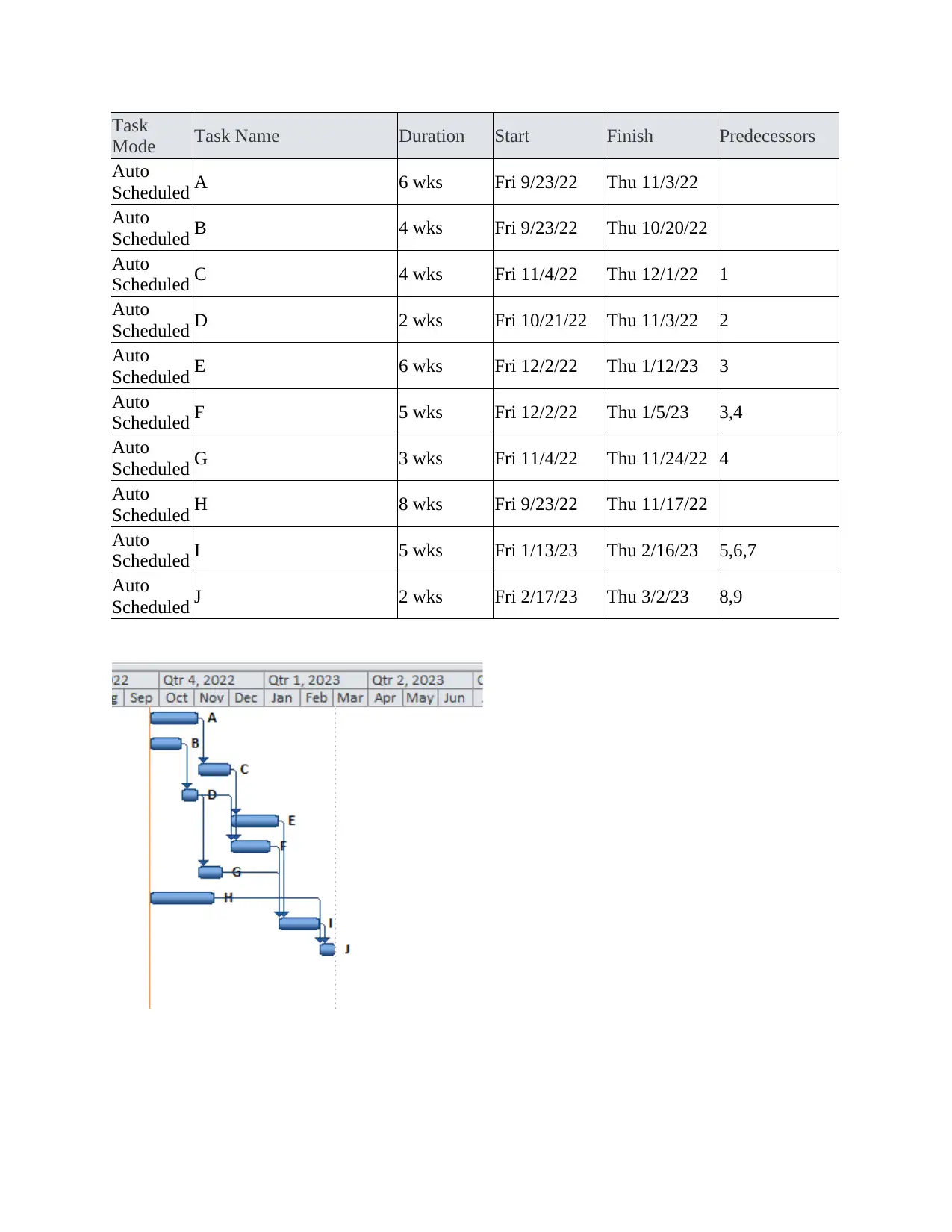
Task
Mode Task Name Duration Start Finish Predecessors
Auto
Scheduled A 6 wks Fri 9/23/22 Thu 11/3/22
Auto
Scheduled B 4 wks Fri 9/23/22 Thu 10/20/22
Auto
Scheduled C 4 wks Fri 11/4/22 Thu 12/1/22 1
Auto
Scheduled D 2 wks Fri 10/21/22 Thu 11/3/22 2
Auto
Scheduled E 6 wks Fri 12/2/22 Thu 1/12/23 3
Auto
Scheduled F 5 wks Fri 12/2/22 Thu 1/5/23 3,4
Auto
Scheduled G 3 wks Fri 11/4/22 Thu 11/24/22 4
Auto
Scheduled H 8 wks Fri 9/23/22 Thu 11/17/22
Auto
Scheduled I 5 wks Fri 1/13/23 Thu 2/16/23 5,6,7
Auto
Scheduled J 2 wks Fri 2/17/23 Thu 3/2/23 8,9
Mode Task Name Duration Start Finish Predecessors
Auto
Scheduled A 6 wks Fri 9/23/22 Thu 11/3/22
Auto
Scheduled B 4 wks Fri 9/23/22 Thu 10/20/22
Auto
Scheduled C 4 wks Fri 11/4/22 Thu 12/1/22 1
Auto
Scheduled D 2 wks Fri 10/21/22 Thu 11/3/22 2
Auto
Scheduled E 6 wks Fri 12/2/22 Thu 1/12/23 3
Auto
Scheduled F 5 wks Fri 12/2/22 Thu 1/5/23 3,4
Auto
Scheduled G 3 wks Fri 11/4/22 Thu 11/24/22 4
Auto
Scheduled H 8 wks Fri 9/23/22 Thu 11/17/22
Auto
Scheduled I 5 wks Fri 1/13/23 Thu 2/16/23 5,6,7
Auto
Scheduled J 2 wks Fri 2/17/23 Thu 3/2/23 8,9
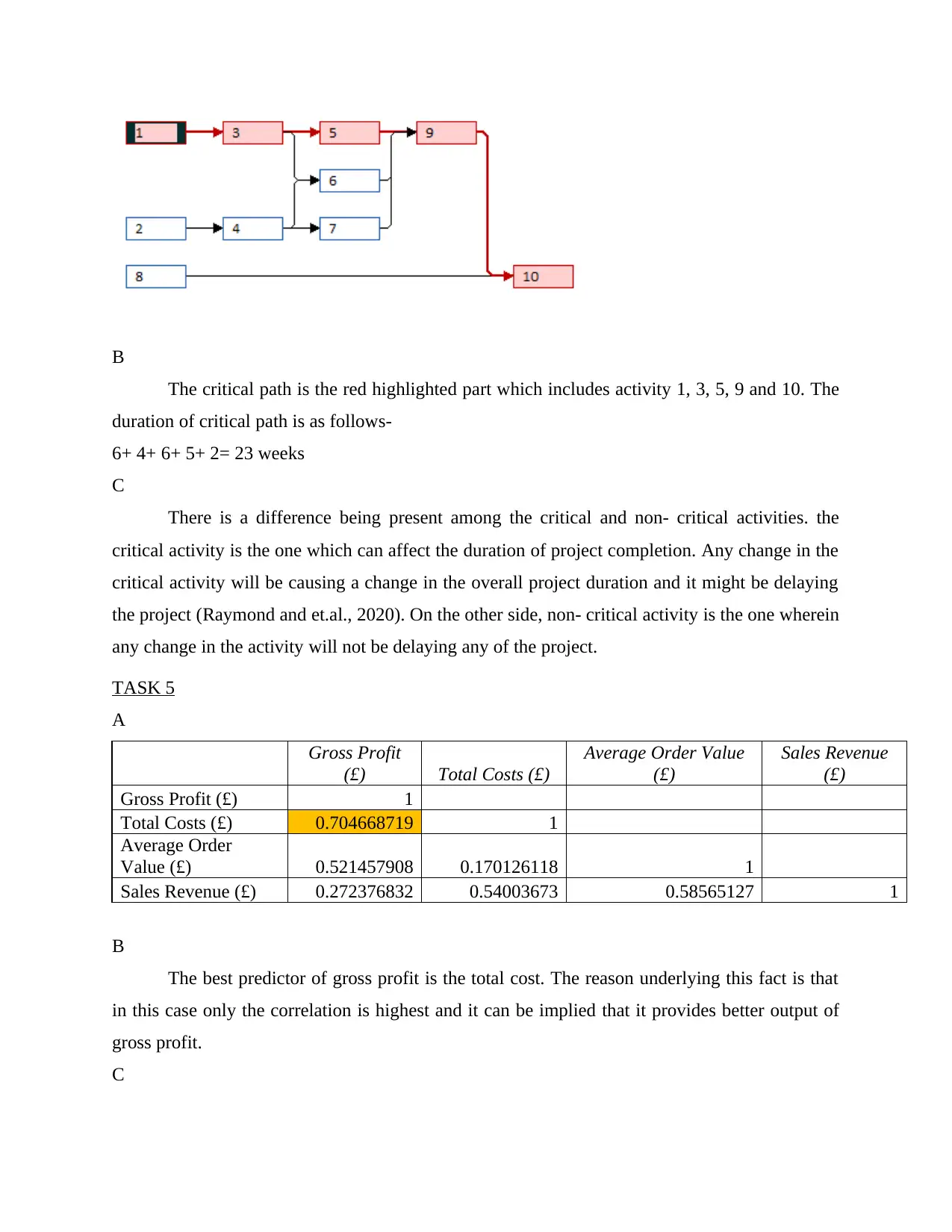
B
The critical path is the red highlighted part which includes activity 1, 3, 5, 9 and 10. The
duration of critical path is as follows-
6+ 4+ 6+ 5+ 2= 23 weeks
C
There is a difference being present among the critical and non- critical activities. the
critical activity is the one which can affect the duration of project completion. Any change in the
critical activity will be causing a change in the overall project duration and it might be delaying
the project (Raymond and et.al., 2020). On the other side, non- critical activity is the one wherein
any change in the activity will not be delaying any of the project.
TASK 5
A
Gross Profit
(£) Total Costs (£)
Average Order Value
(£)
Sales Revenue
(£)
Gross Profit (£) 1
Total Costs (£) 0.704668719 1
Average Order
Value (£) 0.521457908 0.170126118 1
Sales Revenue (£) 0.272376832 0.54003673 0.58565127 1
B
The best predictor of gross profit is the total cost. The reason underlying this fact is that
in this case only the correlation is highest and it can be implied that it provides better output of
gross profit.
C
The critical path is the red highlighted part which includes activity 1, 3, 5, 9 and 10. The
duration of critical path is as follows-
6+ 4+ 6+ 5+ 2= 23 weeks
C
There is a difference being present among the critical and non- critical activities. the
critical activity is the one which can affect the duration of project completion. Any change in the
critical activity will be causing a change in the overall project duration and it might be delaying
the project (Raymond and et.al., 2020). On the other side, non- critical activity is the one wherein
any change in the activity will not be delaying any of the project.
TASK 5
A
Gross Profit
(£) Total Costs (£)
Average Order Value
(£)
Sales Revenue
(£)
Gross Profit (£) 1
Total Costs (£) 0.704668719 1
Average Order
Value (£) 0.521457908 0.170126118 1
Sales Revenue (£) 0.272376832 0.54003673 0.58565127 1
B
The best predictor of gross profit is the total cost. The reason underlying this fact is that
in this case only the correlation is highest and it can be implied that it provides better output of
gross profit.
C
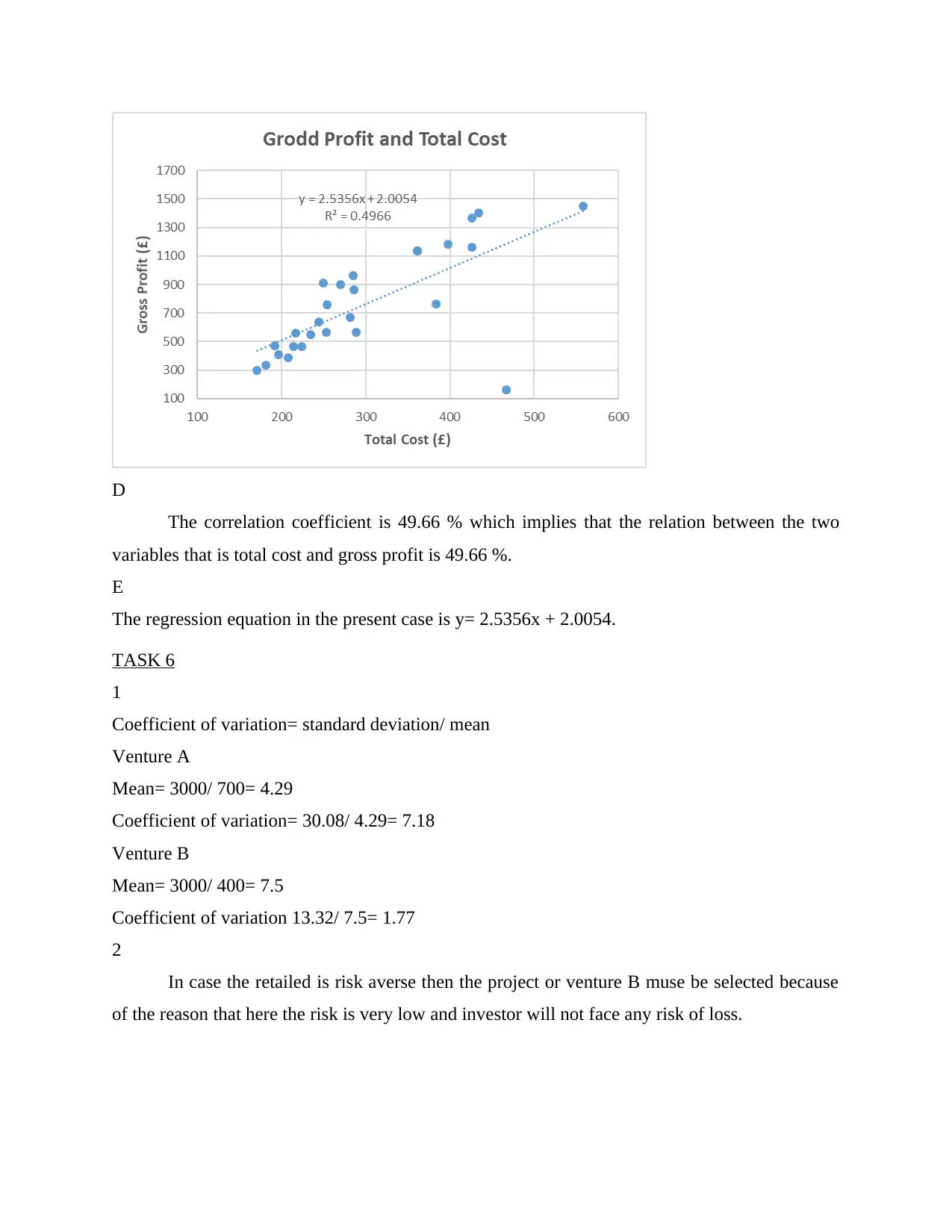
D
The correlation coefficient is 49.66 % which implies that the relation between the two
variables that is total cost and gross profit is 49.66 %.
E
The regression equation in the present case is y= 2.5356x + 2.0054.
TASK 6
1
Coefficient of variation= standard deviation/ mean
Venture A
Mean= 3000/ 700= 4.29
Coefficient of variation= 30.08/ 4.29= 7.18
Venture B
Mean= 3000/ 400= 7.5
Coefficient of variation 13.32/ 7.5= 1.77
2
In case the retailed is risk averse then the project or venture B muse be selected because
of the reason that here the risk is very low and investor will not face any risk of loss.
The correlation coefficient is 49.66 % which implies that the relation between the two
variables that is total cost and gross profit is 49.66 %.
E
The regression equation in the present case is y= 2.5356x + 2.0054.
TASK 6
1
Coefficient of variation= standard deviation/ mean
Venture A
Mean= 3000/ 700= 4.29
Coefficient of variation= 30.08/ 4.29= 7.18
Venture B
Mean= 3000/ 400= 7.5
Coefficient of variation 13.32/ 7.5= 1.77
2
In case the retailed is risk averse then the project or venture B muse be selected because
of the reason that here the risk is very low and investor will not face any risk of loss.
Paraphrase This Document
Need a fresh take? Get an instant paraphrase of this document with our AI Paraphraser

TASK 7
With the help of the study it is clear that having proper knowledge relating to numeracy
skill is very important. In the current assignment the analysis of data and use of appropriate tools
was undertaken and this went well for me. Along with this, the most challenging task for me
within the completion of project was to appropriately use the type of data (Montgomery and
Runger, 2018). There are different types of data analysis tool and using is wisely was the most
complex task. In the future, I will like to take care of using the dataset in such a manner that the
objective of the data analysis is being undertaken. also I learnt the different skills like
researching, problem solving, data analysis and evaluation and many others.
PART 2
A
highest activity
cost 400000
highest activity
unit 34000
lowest activity cost 195000
lowest activity unit 14000
Variable cost
Highest activity cost – lowest activity cost / Highest activity unit -Lowest activity
units
10.25
fixed cost Highest activity cost - (variable cost per unit* Highest activity units)
51500
B
Break- even point fixed cost / (sales per unit – variable cost per unit)
5282.051282
C
number of units sold for desired profit of
60000
units of sales = (fixed cost + target
profit)/contribution margin per unit
With the help of the study it is clear that having proper knowledge relating to numeracy
skill is very important. In the current assignment the analysis of data and use of appropriate tools
was undertaken and this went well for me. Along with this, the most challenging task for me
within the completion of project was to appropriately use the type of data (Montgomery and
Runger, 2018). There are different types of data analysis tool and using is wisely was the most
complex task. In the future, I will like to take care of using the dataset in such a manner that the
objective of the data analysis is being undertaken. also I learnt the different skills like
researching, problem solving, data analysis and evaluation and many others.
PART 2
A
highest activity
cost 400000
highest activity
unit 34000
lowest activity cost 195000
lowest activity unit 14000
Variable cost
Highest activity cost – lowest activity cost / Highest activity unit -Lowest activity
units
10.25
fixed cost Highest activity cost - (variable cost per unit* Highest activity units)
51500
B
Break- even point fixed cost / (sales per unit – variable cost per unit)
5282.051282
C
number of units sold for desired profit of
60000
units of sales = (fixed cost + target
profit)/contribution margin per unit
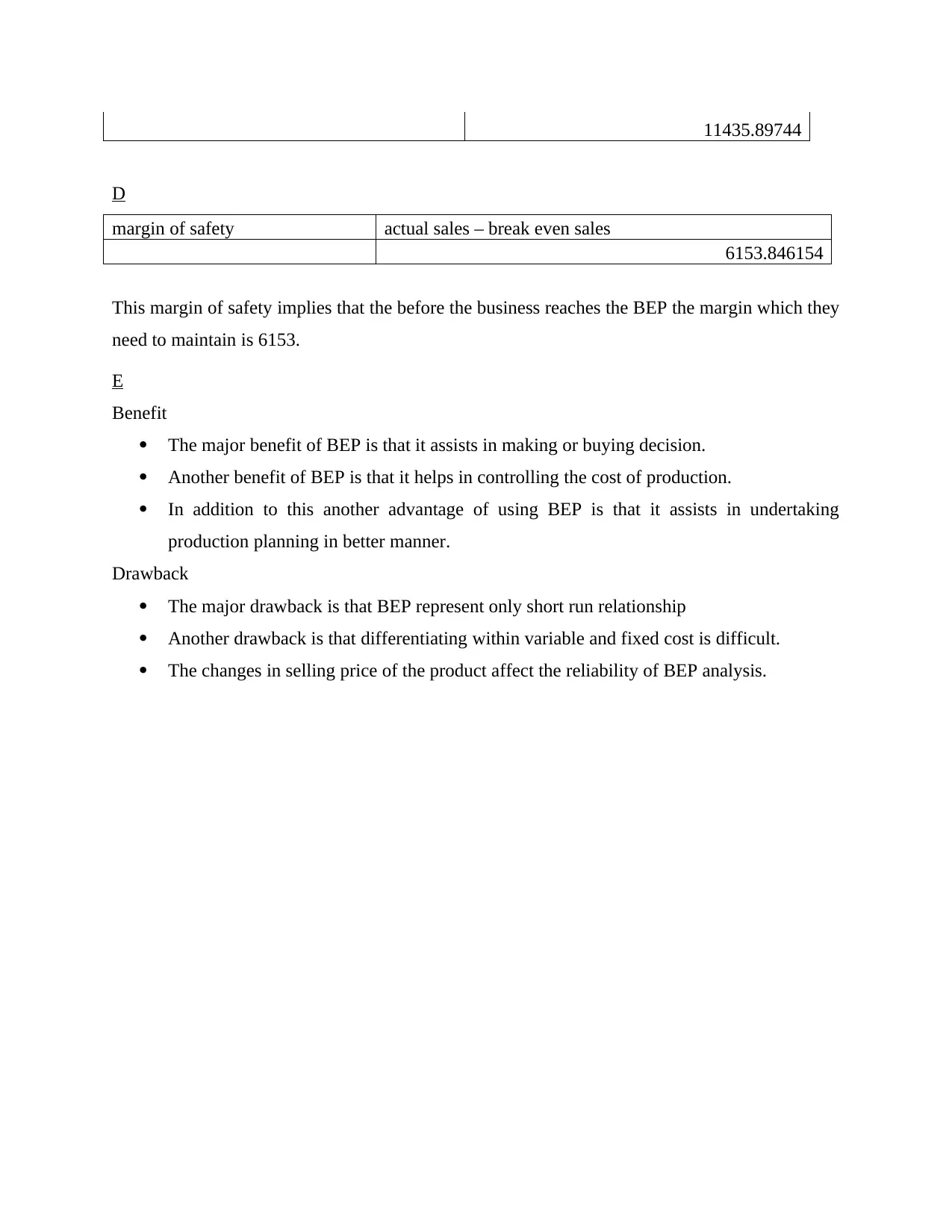
11435.89744
D
margin of safety actual sales – break even sales
6153.846154
This margin of safety implies that the before the business reaches the BEP the margin which they
need to maintain is 6153.
E
Benefit
The major benefit of BEP is that it assists in making or buying decision.
Another benefit of BEP is that it helps in controlling the cost of production.
In addition to this another advantage of using BEP is that it assists in undertaking
production planning in better manner.
Drawback
The major drawback is that BEP represent only short run relationship
Another drawback is that differentiating within variable and fixed cost is difficult.
The changes in selling price of the product affect the reliability of BEP analysis.
D
margin of safety actual sales – break even sales
6153.846154
This margin of safety implies that the before the business reaches the BEP the margin which they
need to maintain is 6153.
E
Benefit
The major benefit of BEP is that it assists in making or buying decision.
Another benefit of BEP is that it helps in controlling the cost of production.
In addition to this another advantage of using BEP is that it assists in undertaking
production planning in better manner.
Drawback
The major drawback is that BEP represent only short run relationship
Another drawback is that differentiating within variable and fixed cost is difficult.
The changes in selling price of the product affect the reliability of BEP analysis.
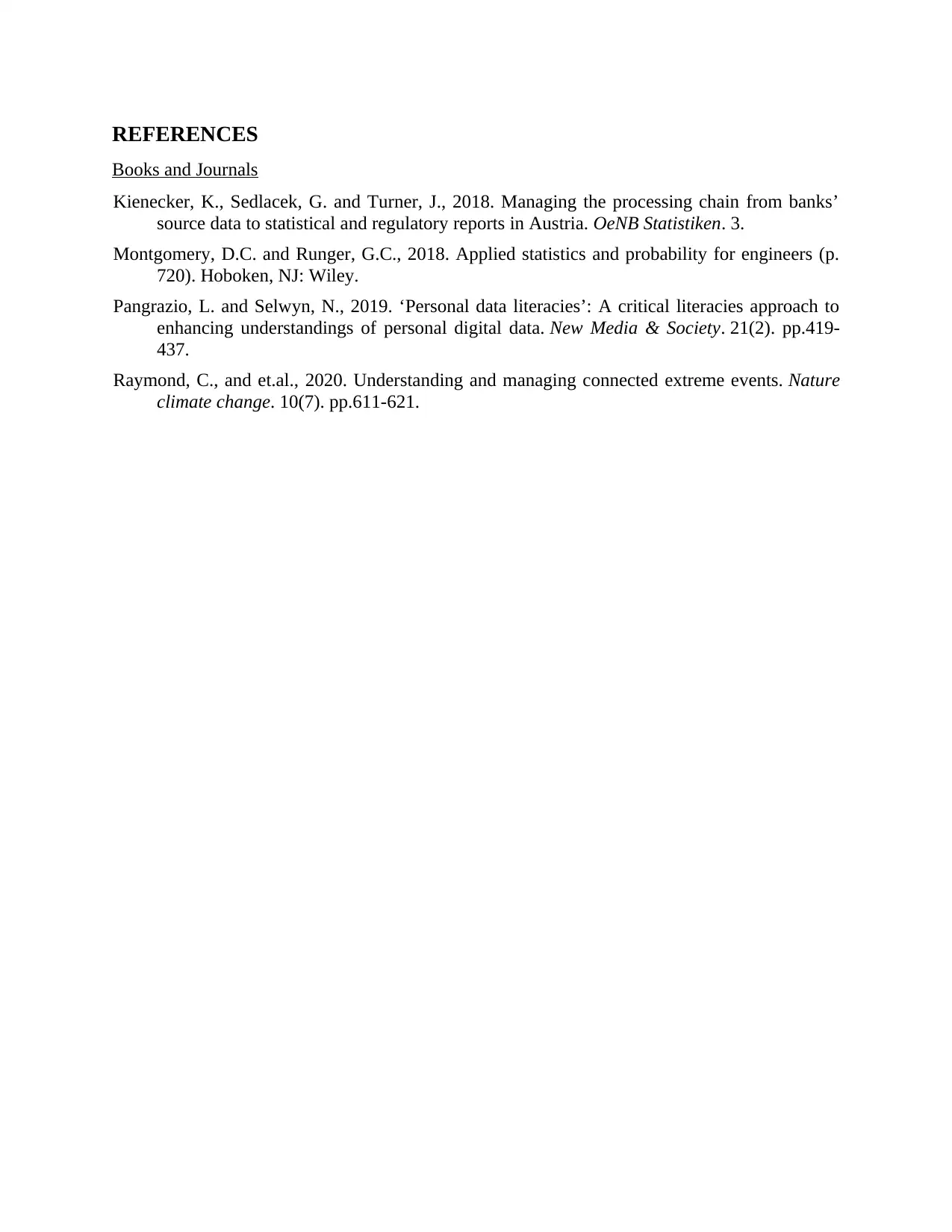
REFERENCES
Books and Journals
Kienecker, K., Sedlacek, G. and Turner, J., 2018. Managing the processing chain from banks’
source data to statistical and regulatory reports in Austria. OeNB Statistiken. 3.
Montgomery, D.C. and Runger, G.C., 2018. Applied statistics and probability for engineers (p.
720). Hoboken, NJ: Wiley.
Pangrazio, L. and Selwyn, N., 2019. ‘Personal data literacies’: A critical literacies approach to
enhancing understandings of personal digital data. New Media & Society. 21(2). pp.419-
437.
Raymond, C., and et.al., 2020. Understanding and managing connected extreme events. Nature
climate change. 10(7). pp.611-621.
Books and Journals
Kienecker, K., Sedlacek, G. and Turner, J., 2018. Managing the processing chain from banks’
source data to statistical and regulatory reports in Austria. OeNB Statistiken. 3.
Montgomery, D.C. and Runger, G.C., 2018. Applied statistics and probability for engineers (p.
720). Hoboken, NJ: Wiley.
Pangrazio, L. and Selwyn, N., 2019. ‘Personal data literacies’: A critical literacies approach to
enhancing understandings of personal digital data. New Media & Society. 21(2). pp.419-
437.
Raymond, C., and et.al., 2020. Understanding and managing connected extreme events. Nature
climate change. 10(7). pp.611-621.
1 out of 10
Related Documents
Your All-in-One AI-Powered Toolkit for Academic Success.
+13062052269
info@desklib.com
Available 24*7 on WhatsApp / Email
![[object Object]](/_next/static/media/star-bottom.7253800d.svg)
Unlock your academic potential
© 2024 | Zucol Services PVT LTD | All rights reserved.





